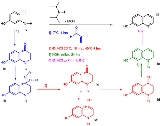
One-pot synthesis
Encyclopedia
In chemistry
a one-pot synthesis is a strategy to improve the efficiency of a chemical reaction
whereby a reactant is subjected to successive chemical reactions in just one reactor. This is much desired by chemists because avoiding a lengthy separation process
and purification of the intermediate chemical compounds would save time and resources while increasing chemical yield.
An example of a one-pot synthesis is the total synthesis
of tropinone
or the Gassman indole synthesis
. Sequential one-pot syntheses can be used to generate even complex targets with multiple stereocentres, such as oseltamivir
, which may significantly shorten the number of steps required overall and have important commercial implications.
A sequential one-pot synthesis with reagents added to a reactor one at a time and without work-up is also called a telescoping synthesis.
In one such procedure the reaction of 3-N-tosylaminophenol I with acrolein
II affords a hydroxyl
substituted quinoline
III through 4 sequential steps without workup of the intermediate products :

Chemistry
Chemistry is the science of matter, especially its chemical reactions, but also its composition, structure and properties. Chemistry is concerned with atoms and their interactions with other atoms, and particularly with the properties of chemical bonds....
a one-pot synthesis is a strategy to improve the efficiency of a chemical reaction
Chemical reaction
A chemical reaction is a process that leads to the transformation of one set of chemical substances to another. Chemical reactions can be either spontaneous, requiring no input of energy, or non-spontaneous, typically following the input of some type of energy, such as heat, light or electricity...
whereby a reactant is subjected to successive chemical reactions in just one reactor. This is much desired by chemists because avoiding a lengthy separation process
Separation process
In chemistry and chemical engineering, a separation process, or simply a separation, is any mass transfer process used to convert a mixture of substances into two or more distinct product mixtures, at least one of which is enriched in one or more of the mixture's constituents. In some cases, a...
and purification of the intermediate chemical compounds would save time and resources while increasing chemical yield.
An example of a one-pot synthesis is the total synthesis
Total synthesis
In organic chemistry, a total synthesis is, in principle, the complete chemical synthesis of complex organic molecules from simpler pieces, usually without the aid of biological processes. In practice, these simpler pieces are commercially available in bulk and semi-bulk quantities, and are often...
of tropinone
Tropinone
Tropinone is an alkaloid, famously synthesised in 1917 by Robert Robinson as a synthetic precursor to atropine, a scarce commodity during World War I. Tropinone and the alkaloids cocaine and atropine all share the same tropane core structure.-Synthesis:...
or the Gassman indole synthesis
Gassman indole synthesis
The Gassman indole synthesis is a series of chemical reactions used to synthesize substituted indoles from aniline.This is a one-pot chemical reaction, and none of the intermediates are isolated. R1 can be hydrogen or alkyl, while R2 works best with aryl, but can also be alkyl...
. Sequential one-pot syntheses can be used to generate even complex targets with multiple stereocentres, such as oseltamivir
Oseltamivir
Oseltamivir INN , an antiviral drug, slows the spread of influenza virus between cells in the body by stopping the virus from chemically cutting ties with its host cell; median time to symptom alleviation is reduced by 0.5–1 day. The drug is sold under the trade name Tamiflu, and is taken orally...
, which may significantly shorten the number of steps required overall and have important commercial implications.
A sequential one-pot synthesis with reagents added to a reactor one at a time and without work-up is also called a telescoping synthesis.
In one such procedure the reaction of 3-N-tosylaminophenol I with acrolein
Acrolein
Acrolein is the simplest unsaturated aldehyde. It is produced widely but is most often immediately reacted with other products due to its instability and toxicity...
II affords a hydroxyl
Phenols
In organic chemistry, phenols, sometimes called phenolics, are a class of chemical compounds consisting of a hydroxyl group bonded directly to an aromatic hydrocarbon group...
substituted quinoline
Quinoline
Quinoline is a heterocyclic aromatic organic compound. It has the formula C9H7N and is a colourless hygroscopic liquid with a strong odour. Aged samples, if exposed to light, become yellow and later brown...
III through 4 sequential steps without workup of the intermediate products :


